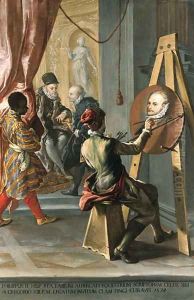Giovan Antonio Burrini Paintings
Giovan Antonio Burrini was an Italian Baroque painter born in 1656 in Bologna, a city that during his lifetime was a vibrant center for the arts and the home of the renowned Accademia di San Luca. Burrini's style was heavily influenced by the Bolognese School and he is often associated with the late Baroque period, with his work reflecting the transition towards the Rococo style that emerged in the early 18th century.
Burrini received his initial training in the studio of Domenico Maria Canuti. However, his style was also significantly shaped by the works of other leading Bolognese artists such as Lorenzo Pasinelli and Flaminio Torre. Moreover, Burrini was influenced by the dynamic and dramatic compositions of the Carracci family, prominent figures in Bolognese art a generation before him, and by the Venetian colorism that was becoming increasingly popular during his time.
Throughout his career, Burrini completed numerous commissions for religious and secular patrons, painting altarpieces, frescoes, and canvas works that were praised for their vibrant color palette and dynamic movement. His frescoes can be found decorating the ceilings and walls of various churches and buildings in Bologna. One of his most notable works is the ceiling fresco in the Palazzo Marescalchi.
Despite his success, Burrini did not establish a large workshop or school, unlike some of his contemporaries. However, his influence on the development of painting in Bologna and the broader region was nonetheless significant, with his works reflecting both the continuation and transformation of the Baroque tradition in Italian art.
Giovan Antonio Burrini's career spanned over seven decades, and he continued to be active in the Bolognese art scene until his death in 1727. His legacy is preserved in the collections of various Italian museums and churches, where his paintings continue to be studied and admired for their contribution to the evolution of late Baroque and early Rococo art.
